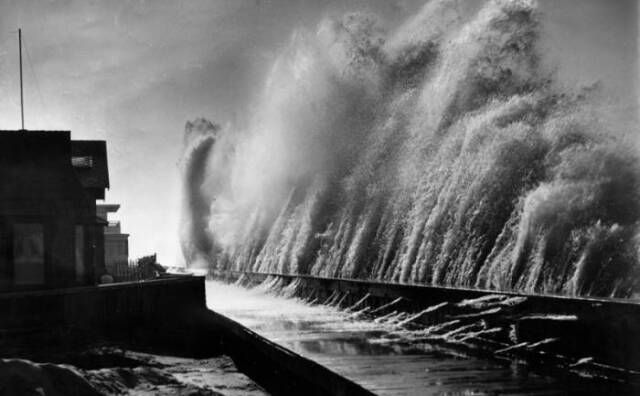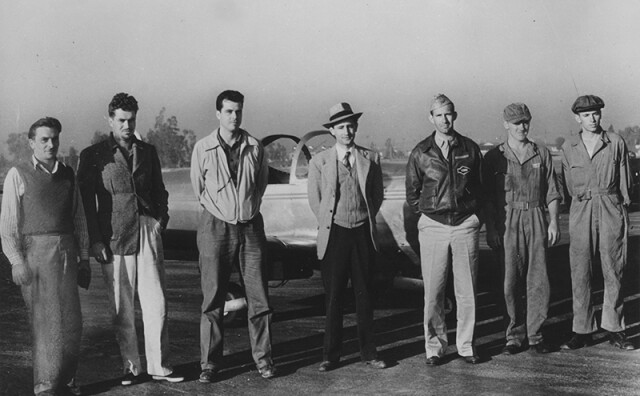A lucky few got a glimpse of the interior of the revamped Vista Theater on Sunset Boulevard last week, one of the last remaining single-screen movie theaters in the Southland, when owner Quentin Tarantino held a special screening of the 1993 cult classic True Romance.
The Vista — with a new 70 mm projection system, sound system, and 21-seat screening room and café named “Coffy,” after the 1973 Pam Grier film — opens officially on Friday at 4473 Sunset Dr., with horror maestro Eli Roth’s Thanksgiving.
The rebirth is the latest chapter in the century-long saga of one of L.A.’s most famous historic theaters. “The history of the Vista is quite surprising, and full of ups and down, and I for one find its resilience to be the most exciting part,” says Celine Vacher, of the Los Feliz Neighborhood Council.
To tell its story, you need to go all the way back to the birth of Hollywood.
-
Nonprofit's launching fundraiser to keep it afloat
-
USC study documents what residents want from trees
-
What candidates can — and can't — say they do
Sunset Boulevard
Filmmaking came to the East Hollywood/Los Feliz area in 1912, when producers L.L. Burns and Harry Revier leased a fig orchard on Sunset Boulevard. On this farmland they built a rustic studio, which was soon renamed Reliance Film Company. Reliance quickly hired pioneering director D. W. Griffith, who brought along his silent film stars Lillian and Dorothy Gish.
Griffith eventually gained control of the studio, which he renamed Fine Arts Studio. In 1914, Griffith built a sprawling replica of a southern antebellum town around the junction of Sunset and Hollywood Boulevards. This set was used for his revolutionary, highly controversial 1915 racist epic The Birth of a Nation, which many historians point to as the first blockbuster full-length feature.
The next movie Griffith set at Sunset Junction would become part of Los Angeles lore. In this quiet rural neighborhood, still dotted with farmhouses and ranches, Griffith constructed a towering plaster set for his 1916 epic Intolerance. Meant to portray the ancient palace of Belshazzar, King of Babylon, the set covered an astounding three city blocks.
“Belshazzar’s Feast beneath Egyptian blue skies,” writer Kenneth Anger wrote in his infamous 1959 expose Hollywood Babylon, “spread out under the blazing California sun: more than four thousand extras recruited from L.A. paid an unheard-of two dollars a day plus box lunch, plus carfare.”

After filming, the set remained up in some form until 1922, becoming a playground for local children. By then, the area was becoming a hub for silent productions, crew bungalows, and stars’ mansions. “Los Feliz was home to Walt Disney’s very first studios, Cecil B. DeMille’s estate where Charlie Chaplin once resided, and even the Vitagraph studios where parts of The Jazz Singer (the first movie with sound) were filmed,” says Vacher.
Egyptian revival style
So it was fitting that the theatrical impresario Lou Bard chose to build the latest in his string of theaters at the fabled intersection of Hollywood and Sunset Boulevards, known as “the great crossroads of Los Angeles.” On Oct. 9, 1923, the 838-seat single screen theater, said to have been called Lou Bard Playhouse or Bard’s Hollywood, opened with a special vaudeville show and the short Tips, starring child star Baby Peggy — who also appeared on stage.
The theater design was as trendy as it could be. Designed by architect Lewis A. Smith, the exterior was constructed in the popular Spanish Mission Revival style. But it was the interior that was truly a feast for the imagination. Designed in the peculiarly western “Egyptian revival” style (popularized by the discovery of King Tut’s tomb in 1922), the interior was a brightly colored riot of golden pharaohs, goddesses, and lamps shaped like pyramids.
According to the Los Angeles Times, the theater was the site for all important industry previews during the golden age of silent film. But Bard was not as successful as he would have liked, and he reportedly sold the theater in 1927. It was renamed the Vista.
Over the decades, the Vista went through many owners. But it was reliably a popular neighborhood theater, even as larger, showier movie palaces sprang up all over Los Angeles.

Controversies over the years
Yet the small but mighty theater would find itself the center of controversies which cemented its place in history. In 1948, the theater capitalized on its historic location by announcing a revival of the problematic The Birth of a Nation, only days after D.W. Griffith's death on July 23, 1948. The Hollywood Reporter noted the choice, in a short article headlined “Opportunism!” It read:
Coming — D.W. Griffith’s “The Birth of a Nation” starting July 28, so the Vista Sunset and Hollywood announces. The theater is across the street from the old Griffith Studio and the site of many location shots for the picture. Filmdom last night predicted the departed showman’s hits would enjoy a national revival.
Disturbed Angelenos immediately took action. Allen M. Metcalf, a local candidate from the Progressive Party, went to the theater to confront the management. “The manager of the theater,” the Los Angeles Times reported, “pointed out that the movie showed the skeleton in the closet of the nation and denied that the cinema was incitement for a riot.”
Progressives were unconvinced. Around 20 Black and white civil rights activists formed a picket line in an attempt to block customers from seeing the film. However, the revival continued.
Charges of un-American values
Controversy came again in the 1950s, when the theater reopened as the Vista Continental. Capitalizing on the growing popularity of foreign films, the theater boasted that it was the only SoCal theater showing first-run films from the Soviet Union. This led locals to complain that the theater was promoting un-American, Communist values at the height of the Cold War. But the theater soldiered on.
The biggest test for the Vista came in the 1960s. During that era, the theater began showing pornographic films, including same-sex films. Irate, the city revoked its operating permit. The Vista fought back, and in 1968 the case was heard in the California Supreme Court.
The Vista won the case, in a decisive blow against anti-gay governance. “The court ruled, in a 5-2 decision, that the law is ‘overly broad’ and threatens to deny theater operators their rights of free speech and press,” the Los Angeles Times reported in June 1968.
“The Court ruled that Stewart Burton, manager of the Vista Theater, should be granted a writ of prohibition against the Los Angeles Board of police commissioners, which did not renew his license.”
Over the next three decades, the theater changed hands several times before it was purchased by Landmark Theatres in 1982. It became known for reviving classic films like Harold and Maude and Gone with the Wind, but business was slow, as VHS decimated art houses nationwide.
A neighborhood gathering place
In 1997, the Vista was purchased by Lance Alspaugh’s Vintage Theater Group. Alspaugh made community outreach a priority. It became known for its very own Walk of Fame, featuring handprints and footprints from stars like John Landis, Elvira, Tatum and Ryan O’Neal, and Baby Peggy herself.
It’s been an integral part of Los Feliz because it’s intentionally embedded itself in the community.
“It’s been an integral part of Los Feliz because it’s intentionally embedded itself in the community,” Vacher says. “Take the longtime manager [Victor Martinez], for example, every big opening night he greets moviegoers in full costume. It’s become a tradition and locals all have their own sets of memories with him as he makes everyone feel like a welcomed friend.”
The Vista became an important gathering place in the area, known for its welcoming atmosphere, epitomized by Martinez (who is reportedly currently on the board of the theater). The theater was rented out for weddings, late night screenings, and was the home of Thomas Starr King Middle School’s annual animation and film festival. There was a Secret Movie Club, and local filmmakers were thrilled when they had premieres at their neighborhood theater.
“I had my first movie premiere at the Vista, which we sold out,” says filmmaker Kestrin Pantera, whose film Let’s Ruin it with Babies premiered in 2013. “It was an…amazing all-night karaoke party and a dream come true to be on the marquee.”
The pandemic shuttered the Vista, which closed in 2020. The marquee, which read “To Be Continued…” became a hopeful sight for weary travelers driving down Sunset Boulevard during the shutdown.
What Tarantino says is next for the theater
But the Vista had not taken its final bow. In 2021, it was announced that director Quentin Tarantino, who saved the historic New Beverly Cinema when he purchased it in 2007, had bought the movie house. “I would not have handed the keys to the Vista over to just anybody,” Alspaugh told the Los Angeles Times.
“It’s no secret that Tarantino often pays homage to Hollywood history in his films, so it feels all the more appropriate that someone with such reverence for the art of filmmaking would be the new custodian of this iconic theater in its iconic location,” Vacher says.
Tarantino vowed to show only movies on film at the new Vista, instead of digital projection. He also clearly valued the communal aspects Alspaugh had fostered over the years. “I do think boutique cinemas will actually thrive at this time,” Tarantino told the Los Angeles Times. “I got a living room. I want to go to a movie theater.”
Over the last two years the Vista has undergone a dramatic makeover. “Quentin basically retained the auditorium — it’s intact, it’s been rehabbed and it’s still new and beautiful, but the overall auditorium is in intact condition,” said Alspaugh, who has remained as chief operating officer.
“The intention is to run mostly first-run and occasional classics or repertory film,” Alspaugh told Variety’s Pat Saperstein. “There will be sections of time where you might see classic repertory titles on film for brief interludes. In the future, you’ll see some late shows of classic films and I think you’ll see morning shows of classic films.”
Whatever happens, cinephiles are just happy that their favorite historic theater is again part of the community where it has thrived for a century.
“The entire neighborhood has been anxiously awaiting the Vista’s comeback,” Vacher says. “It’s been on everyone’s lips. We’re all so eager to see that corner revived and active, no doubt we’ll all be flocking to it trying to make up for lost time.”







